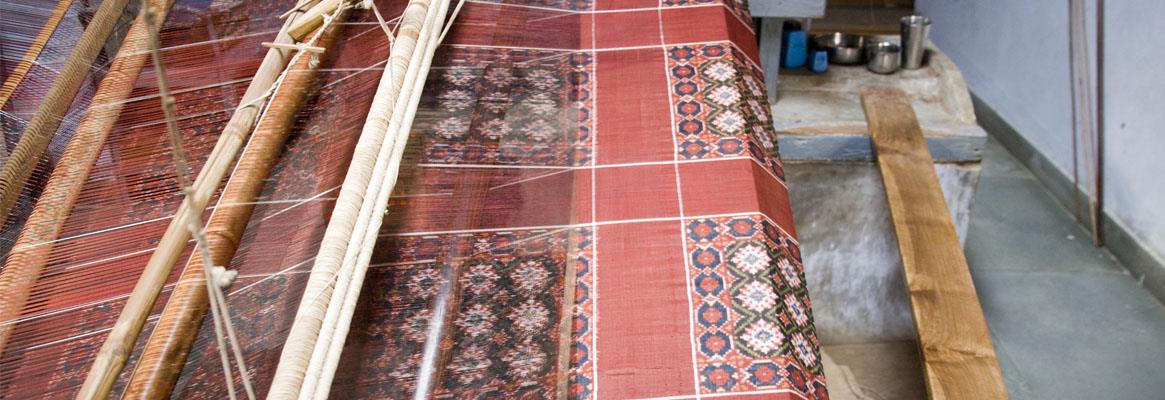The COVID-19-induced crisis has badly hit Patola weavers from Gujarat. Their businesses have drastically reduced as there are few takers of the expensive and exclusive sarees and other garments created using this rare technique. Many weavers run the risk of opting out of the trade to survive if the pandemic continues for long.
Patola sarees from Gujarat have been one of the most sought after designerwear for women for many centuries. Traditionally manufactured in Patan, about two hours from Ahmedabad by road, Patola was earlier a highly expensive exclusive saree made by hand by skilled artisans. It was then only affordable by women of royal and aristocratic families. Patola is actually a plural word in Gujarati dialect. A single saree is called patolu. The double ikat sari is usually made from silk.
However, in the last few decades, weavers have developed a prototype art in Gujarat to manufacture reasonably-priced patola and to use the same weaving art for manufacturing shawls, dupatta and dress material as well. The art has travelled across continents and is now popular across the globe. Even Hindi film celebrities are seen flaunting the patola at posh events and parties. The handloom six yard caught eyeballs when style diva Malaika Arora draped it at the Dadasaheb International Film Festival Awards last February. Arora's patola had become the talk of the town at that time.
History
It is believed that in the 12th century CE, people of the Salvi caste who mastered the art of patola travelled from present day Maharashtra to Gujarat to gain patronage of the Chalukya Rajputs. About 700 weavers migrated to the then capital city of Patan. It is said that king Kumarpal had himself requested them to come. Patola were then considered super premium cloth and kings of the Solanki (Chalukya) dynasty used to dress in the choicest patola silk clothes on special occasions.
Patola has been an important component of Gujarati dressing and weddings over centuries now. 'Patan thi Patola mongha lavjo' has been a popular folk song in Gujarati language, which literally means a wife urging her husband to bring for her the highly expensive patola while returning from his visit from Patan. Surendranagar in western Gujarat is now the new manufacturing hub for patola with about 2,500 artisans engaged full time in and around the district.
The Salvis
Rahul Vinayak Salvi, a master weaver from Patan, says his family has been into the traditional art of weaving patola for 30 generations spanning over 900 years. Patola weaving is a very closely guarded knowhow passed on to the next generation by teaching it to the sons of the lineage, according to him. Forget anyone outside the family, even the female members of the family are not given the knowhow. Currently, there are only three such families in the world that manufacture the original patola with natural colours. Salvi sells only five to seven patola every year. A patola at Salvi's shop costs between ?1.5 lakh and ?5 lakh. A team of five to six people work full time for around six months to make a single such saree. Salvi works on customised orders from Mumbai, Hyderabad, Delhi among other places. He also gets orders from the United States and the United Kingdom.
Low cost mass weaving
Over the last few decades, patolas are also being mass manufactured in a more commercial way, which has made the design more affordable. Surendranagar, located around 100 km from Ahmedabad, is now the manufacturing hub of this type of patola. Over 85 per cent weavers in the world are in Surendranagar and surrounding region while a few of them are in Rajkot. In this technique, low cost patola are manufactured, which are for regular and special use but not of premium quality as of Patan weaved sarees.
Difference between Patan patola saree and commercial patola products:
• Commercial patola requires 10 per cent man hours as compared to Patan patola
• Patan patola uses exclusive natural colours that last for more than 100 years. Regular Patola colours fade in a few years.
• Patan patola is prepared on highly fine cloth as compared to regular ones.
• Patan patola weighs quite less
• Original patola is prepared with far superior workmanship
• In commercial patola, a lot of other products like dress materials, chaniya-choli, etc. are available.
In this type of patola, two to three people are required to work for about eight days to create a sari unlike Patan where 30-35 man months are required to manufacture a single saree. This reduces the labour cost drastically. Also these patola do not have the premium workmanship of the original patola. This also reduces the cost.
Although the weavers prefer keeping the materials used and their sources and prices as a trade secret, some factors clearly reveal how the cost is reduced by Surendranagar- and Rajkot-based weavers. The fine art with which Patan artisans prepare the Patola and the material they use keep the weight of the saree under 450 grams. However, the patola sarees available from Surendranagar and Rajkot weigh over 550 grams, and at times going up to 800 grams, due to the less expensive cloth and threads used. The cloth used by Patan master weavers is a special fine cloth, which is far thinner than the low-priced patola available in the market. Natural colours used in the original patola are expensive too and its application techniques are known only to a few.
Master weaver Nagar Makwana's family in Surendranagar has been engaged for 30 years in manufacturing single ikat and double ikat patola clothing. Makwana usually sells patola varieties, which include stoles, chaniya-choli, shawls, handkerchiefs, jackets, in addition to the saree. He has also come up with a patola neck tie for men. Makwana's family of five has skilled artisans for different production processes. Two to three people working take about eight days to complete a saree. The sarees sell starting from ?7000. As per Makwana, there are around 2,500 weavers in and around Surendranagar.
COVID-19 impact
"We have a higher end business that may not be affected by a few months of lockdown. Our customers are usually extremely rich and may not be affected by short-term recessionary trends," Rahul Salvi said. However, their business is down this year by 25 per cent. Now, if the COVID-19 crisis continues for a longer duration, the business may be badly affected. Salvi adds that there have been almost no customers at their retail outlet in Patan since March. The Diwali festival, which usually sees several visitors and tourists, passed without almost any visitor.
Covid effect on Patola business
• Lockdown hits patola business drastically.
• Demand almost nil due to lack of weddings and festival celebrations.
• Super premium business down by 25 per cent.
• Regular patola clothing business down by 80 per cent
• Regular patola saree sales reduced to 10 per cent.
• Prices of patola products reduced to 50 per cent due to stock pile-up and online competition.
• A few weavers have stopped weaving and opted for alternate businesses for survival.
• No non-resident Indian buyers as tourists stopped
Nagar Makwana of Surendranagar said: "Due to the lockdown, business is down by 80 per cent and survival is very difficult right now." Makwana usually works at a mark-up of 50 per cent to earn about ?3 lakh a year. While the overall patola business is down by 80 per cent, patola saree sales are down by 90 per cent, and other low-priced accessories are selling more than sarees now. He doesn't know how his family will survive if the crisis continues.
Rajkot-based weaver Ashish Makwana's family had COVID-19 cases, and that made him close his business for a long period. He sells about 400 patola sarees in a regular year.
Surendrangar-based weaver and seller of patola Hansraj Sindhav said he does not directly sell patola to users, but is engaged in selling to businessmen in Rajkot and Ahmedabad. These sellers either sell the items in retail or supply these to resellers in different parts of India and abroad. However, nobody has been placing orders since March this year. The sales are just a fraction of what it used to be, Sindhav said. It is a similar situation for all weavers.
Patola master weaver Dilip Solanki of Rajkot is having a bad time due to the crisis. His business mostly relies on NRI and domestic tourists who visit Rajkot and buy patola. However, there have been practically not more than 5 per cent visitors from March to Diwali in comparison to what it used to be before. Solanki confirmed that the overall business is down by 80 per cent.
Patola businessman and weaver Darshan Parmar said business has gone to online portals due to the lockdown. Non-weavers have got into the business of selling patola products online. Due to this, the margins have squeezed by 50 per cent as products are sold at low margins online. Darshan is young and tech-savvy, so he also tries to sell the products online. However, most weavers are not conversant with online businesses and have to only rely on brick and mortar model of business.
The risk
Patola making is a very complicated process with 18-20 different tasks, each requiring special skills. Some of the main processes include opening the hank, degumming, spinning, warping, wafting, tie & dye and weaving. The weaving process is a mathematical art where the warp and waft are tied and dyed with a thread to create beautiful patterns. The patterns have to be accurately imagined even before the weaving starts.
All weavers mostly manufacture patola in their homes. All of them generally deploy their family members in the entire weaving process. Patola making is a scientific art known to only a few people. The process knowhow is already under a grave risk of getting endangered. If the COVID-19-induced crisis continues over unreasonable periods, there is a chance the weaving skill will remain with still fewer craftsmen as more people will have to opt out of the trade for survival. The deep market recession may force many such skilled artisans to choose alternate careers to help their families survive.
Delhi-based Jasleen Dhamija, a veteran Indian textile art historian and crafts expert, had publicly mentioned recently that she considers the double ikat weave, the Patan patola, as the most endangered sacred textile of India. The Patan patola also finds a mention in the draft of the Intangible Cultural Heritage list released by the Indian ministry of culture. If there is anybody who can do anything about it, it is the government. But the patola weavers community is small and not organised. They lack a proper effort to pursue their cause with the government to consider them for benefits or other incentives.










Comments